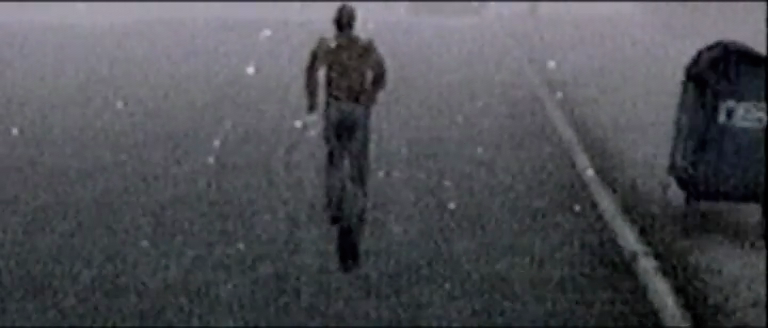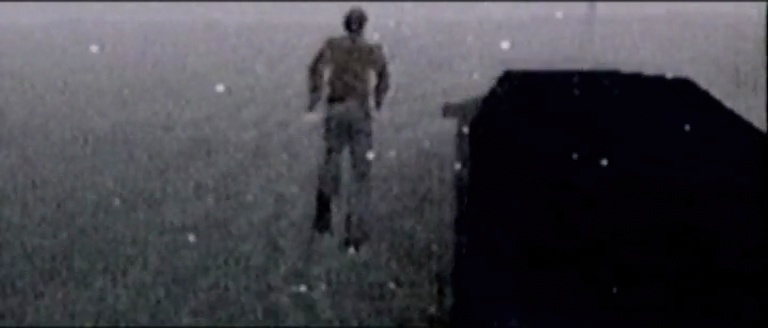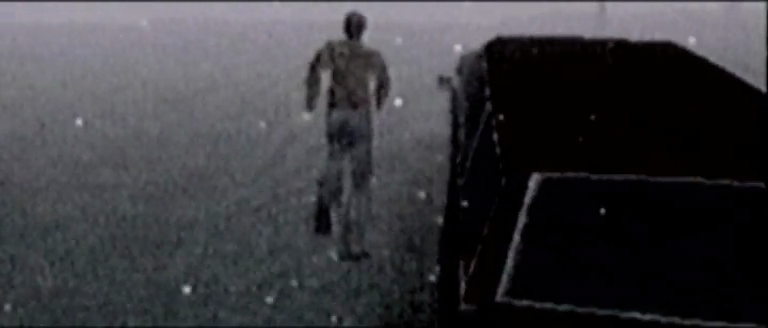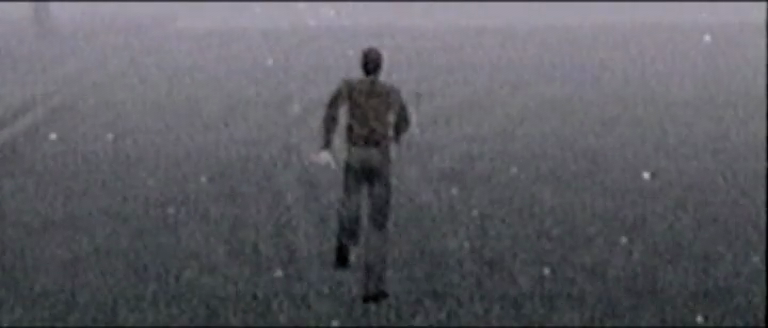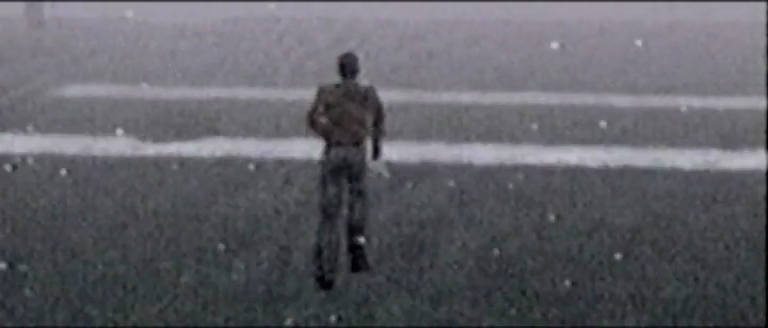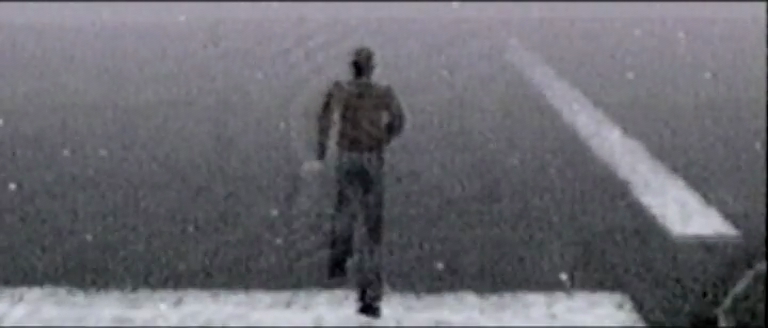EVERYWHERE
Digital video/machinima (720 x 328), color, 11’ 33”, 2007, Denmark
Created by Søren Thilo Funder
In Everywhere, we witness a lone figure navigating through a bleak and surreal urban environment, evoking a sense of isolation and alienation. The desolate terrain appears to be both familiar and foreign, presenting a disorienting experience for the viewer. The man’ continuous movement and evasion of unseen obstacles within the virtual realm challenge conventional notions of escapism, offering a fresh perspective on the concept as an unending cycle of seeking liberation from an undefined void. The piece’s cyclical nature serves as a commentary on the paradoxical nature of escape, as the runner’s repetitive journey highlights the futility of attempting to break free from the inherent boundaries, constraints, and power dynamics of digital media. Through this haunting work, the artist invites us to reflect on the interplay between virtual and real-life experiences, and the inherent limits within the world of gaming.
An artist who specializes in video and installation, Søren Thilo Funder, creates thought-provoking works that blend various cultural tropes, socio-political issues, and popular fictions. These narrative constructions operate within a delicate membrane where fictions and realities intersect, generating fresh interpretations and new meanings. Funder's oeuvre is steeped in both written and unwritten histories, as well as a deep awareness of the paradoxes and complexities of societal engagement. His art explores temporal displacements, nonlinear storytelling, and the emergence of new, unconventional forms of memory. Through his work, Thilo Funder creates immersive spaces that enable unpredictable encounters with the political, temporal, and recollective. He invites the viewer to challenge their preconceptions and explore the unexpected, creating a dialogue that is both deeply personal and universally relevant. Funder received an MA from the Royal Danish Academy of Fine Arts and The School of Art and Architecture at the University of Illinois at Chicago. He is currently finishing a Doctorate program in Artistic Research at The Art Academy, Department of Contemporary Art, University of Bergen in Norway.
Matteo Bittanti: Everywhere appropriates and recontextualizes both video game visuals and mechanics, transforming them into metaphors for more complex processes. What is a video game to you, as an artist? What role does it play in your practice? And which specific title did you appropriate and recontextualize as Everywhere?
Søren Thilo Funder: Everywhere is a rather old work, yet one that has stayed with me and that I return to now and again. For Everywhere, I appropriated the initial gameplay of the 1999 horror classic Silent Hill for the original PlayStation. I had a really vivid memory of having played it back when it was released, and especially the opening scenes, where the lead character is running rather aimlessly through this unidentified, foggy urban area, without a sense of direction, had imprinted itself on my mind. Eight years later, when I dug out the game and an old game console and connected it to a VCR, recording my gameplay, it really still had that enigmatic feel.
Video games have always had a significant presence in my practice. My artistic work unfolds within the field of video art and video installation, but I have always primarily considered my artistic practice to be a time-based one. A temporal artistic practice that comprises all kinds of mediums, but always revolve around a certain temporal exploration, be it narratively, conceptual, durational or experiential; and which is always mirrored or entangled with what I call tempor(e)ality - the timeliness of reality, or how reality unfolds in accordance to time; not only on a phenomenological or conceptual level but on a socio-political one as well. The artwork really comes into effect in the meeting between its temporality and the tempor(e)ality of the surroundings it engages with.
There is a certain temporality linked to the video game, not only inside the fibers of its digital and temporal being, but also within the role it plays in the cultural landscape and the socio-political reality of our everyday lives. I have been thinking a lot about the promise that the video game offers and how it mirrors the promise of living in society. A specific, peculiar idea of freedom, always within the confines of a decisional ecology defined by forced choices. The video game offers a world to inhabit that often does not differ much from the one we inhabit when we are away from the keyboard.
This linkage has only gotten more and more entangled with the proliferation of social media and the gamification of every aspect of life. And with this in mind there seems to open a new possibility for the video game to offer an escape from what it helped to create. The game world now offers a chance to meander, to drift around, to act without purpose. This is something that I think we tend to forget the power of. That gaming is not a waste of time but actually for a young generation might be about reclaiming time.
These are some of the things I’ve been interested in, from the perspective of something poetic and social, but also from the perspective of the industry and more propagandizing uses of the media.
Matteo Bittanti: A Sisyphean logic seems to inform Everywhere: we see a nondescript male character traversing a desolate suburban terrain, desperately trying — and yet inexorably failing — to evade the constraints of the virtual world. Would you describe this situation as inherently tragic or ironic? Also, is he running toward something or is he running from something?
Søren Thilo Funder: In my editing of the sequence, the character is shifted to a new location every time a destination or story-point is on the horizon. This makes for this endless travel. Instead of going nowhere the character seems to be going everywhere. I try not to think of the character as having aim or purpose. It is somehow left up to the viewer to enter narration or to experience something. The work somehow creates an atmosphere and having been lifted from a horror game and displaying this solitary running of course hints at a certain description of the situation. But I guess for me the quality of this character in this situation is that it falls in-between - or is suspended in a becoming. Here the audio of the work also plays a role, I guess.
Matteo Bittanti: Everywhere is a seminal work whose visibility transcends the white cube as it was presented, among other things, on the wall of a huge building in New York in the context of the exhibition Nordic Outbreak. What was the feedback, back then? How did viewers react to the attempt of a video game character to run away from an unknown threat? Did they see a reflection of themselves? Was the big screen like a mirror? Can you describe the work’s history, in terms of display strategies?
Søren Thilo Funder: The first installation of Everywhere was in a white cube setting but the screen was hung so that it faced the wall. The space in between screen and wall only fit one person and the work was with headphones. So in the space one person at a time would experience the artwork (in solitude) and for the rest of the space only the backside of the hanging screen was visible.
Later when the work was shown in public space, in the streets of Manhattan, the quality of the work dramatically shifted. The running of the character became a reaction to its surrounding environment, just like the suburban surroundings of the runner contrasted the inner city vibe of where it was installed. For some it inescapably also had connotations to the events on 9/11, the gray fog landscape of the solitary runner reminiscent of the ash clouds in the streets of Manhattan. But in general I think it was mostly a temporal confrontation - the monotonous running with the erratic nature of passers-by, the aimless travel with the intentionality of everyday commuters.
The work was also shown in an exhibition about video game related art. And here the confrontations with the work were very different again. Visitors of this exhibition expected to interact with the works and had a very hard time accepting that there was no controlling the running character or any interaction possible to aid the work towards resolution.
Matteo Bittanti: I can see how machinima could be considered a step back in a context where interactivity is venerated as the quintessential feature of the medium… But machinima is its own medium, one that eschews interactivity. Among other things, the lack of closure is what makes Everywhere extremely powerful: it reminds me of Jean-Baptiste Wejman’s Concentration Before A Burnout Scene (2011), where any kind of resolution is expected, yet postponed. Was Everywhere originally conceived as a endless, self generating work, or did you intend from the very beginning to assign a specific duration, that is, approximately twelve minutes?
Søren Thilo Funder: Everywhere is always installed in a loop. It was never considered as self-generating, it is a video work and not a new media work. But that said the looped installation of it, and how it in its editing constantly abruptly cuts to somewhere new, makes the experience of it endless. It has no duration conceptually — only one that defines it as a self-contained video file. I always think of my work as something that exists in a nonlinear form, even when it follows a certain linear narrative. Working with video installation the way an audience meets the work is always random and has no defined beginning and ending. This gives it a freedom that I really enjoy: a freedom to be co-narrated, experienced always with the temporality (and atmosphere) brought to the table by the viewer.
Matteo Bittanti: The character’s actions are repetitive, yet futile. The sustained effort does not produce any “real” progress. Is the runner a placeholder for a person who is stuck in a dead-end job, doing the same routine tasks every day, with no possibility of advancement or growth, or where you thinking more about video game playing itself, which is the ultimate pointless kind of “labor”, insofar as it does not produce anything of value outside of “unproductive enjoyment” (inAlfie Bown’sdefinition) or frustrating pleasure, as game play often consists in mind numbing actions that must be performed over and over again: players are basically following their boss’ stultifying instructions (“open this door”, “get the key”, “pull this lever” etc.) for no apparent reason outside of a purportedly “fun” experience. Clearly, the boss, in this case, is the gamer designer…
Søren Thilo Funder: It comes down to decisional ecology. And the character is informed by this ecology.
Matteo Bittanti: Apropos of decisional ecologies, you may be familiar with the genre of endless runners, which I consider as a trailblazing form of digital art, challenging the conventional norms of gameplay and immersing players in a frenetic, ever-evolving experience. Decisions and choices, here, are extremely limited. Showcasing the running body as a kinesthetic machine and characterized by a relentless forward momentum and repetitive gameplay, endless runners can be seen as a radical departure from the more didactic, goal-oriented games of the past. Rather than providing clear-cut objectives and finite endings, these games prioritize the experience of a (linear) “journey” over the attainment of a final destination. The player’s actions, reactions, and decisions all feed into an ever-evolving, frantic performance, a cybernetic feedback loop in which the boundaries between control and chance are continually blurred. To me, Everywhere looks like an endless runner sui generis: the lonely runner is going around in circles even though he seems to be advancing. An invisible wall keeps him at bay. It seems to be as if you’re trying to highlight the delusional nature of these kinds of games. Am I also delusional? Off-track? Lost?
Søren Thilo Funder: There is a forward motion to the character. We experience the running act over the shoulder always with the framing of an advancing trajectory. The form of advance that really is the design premise of many game levels and which cannot accommodate the wanderer. As the possibility of the forward motion advancing the character anywhere disappears, my hope is that other observations and experiences can unfold. The landscape becomes more important; its details and funny (and yes, uncanny) aesthetics and narratives come into focus. A lingering that the game engine and the game designers of the video game most often wants to be in control of. The aimlessness of Everywhere was really an attempt to propose an escape from all the running towards aims.
Matteo Bittanti: Allow me to push the endless runner analogy a bit further. Your work seems to evoke, ante-litteram, Mark Fisher’s distinction between the “weird” and the “eerie”. The cultural critic defined the “weird” as that which is fundamentally other, unnamable and uncategorizable, while the “eerie” is characterized by a feeling of uncanniness, a sense that something is not quite right even though it appears familiar. Endless runners often have an eerie quality, as they present players with environments that are both mundane and strange, with avatars that move in unexpected or inexplicable ways. The relentless forward momentum of the game, combined with the unpredictable movements of obstacles, creates a feeling of disorientation and uncertainty that challenges players’ expectations and pushes them out of their comfort zone. Everywhere is “weird” as the viewer can also witness the avatar’s gestures, but not change his direction or pace - the runner is basically a body without free will. It is also “eerie”, insofar as the space is desolate and nightmarish. In this regard, the sound design is instrumental in creating a sense of dread. The sound of footsteps is interspersed with occasional, unintelligible voices and sounds. I could only hear an occasional, agonizing “Goddamn”. The image itself is blurry and grainy: a “poor image”, as Hito Steyerl would describe it. Plus, it’s snowing — or hailing — and foggy. But if I had to make sense of Everywhere through through a Fisher-eye lens (pardon the atrocious pun), I would say that, like endless runners, this work is evocative of “accelerated culture,” a concept used by the British critic to describe the rapid pace of technological change and the sense of disorientation it creates. Like an endless runner, Everywhere is set in a strange, unsettling environment, where stopping or pausing is not contemplated (as it would inevitably lead to death), and where one can only embrace the unknown. Is Everywhere a commentary of the failures of capitalism, with its delusions about progress and “growth” for growth’s sake? What was your state of mind when you created this work? Can you describe the affective origins of the project?
Søren Thilo Funder: I think that the quality of Everywhere as a poor image is really important here. Visually it takes off from a starting point of console gaming where a new form of immersion was promised. One that related a lot to the cinematic. But it also has a visuality that comes out crude and undone, maybe even obscured. The atmosphere of Elsewhere is very connected to the eerie, in that it teems with a certain absence. There is something here where there should not be and there is also something not here where there really should be something. The eeriness — I am ever closely indebted to the thinking of Mark Fisher — instantly speaks to that which is absent in this desolate purposeless situation and perhaps through that to the absence that all “purpose” likewise teems with. Fisher would say that the eerie is concerned with the difficulty of defining agency. And in that way the eerie necessarily involves forms of speculation. Eeriness is often wrought from capitalist speculation, just like capital itself is at every level eerie. It materializes out of nothing, but nevertheless has an enormous influence on our material reality. Franco Bifo Berardi would even speak of absolute capitalism. The word “everywhere” relates directly to this absolutism and if the character is one that flees, then the question remains: How does one escape something that is everywhere and is absent at the same time?
Matteo Bittanti: I may suffer from selective attention, but I see another trademark of Fisher’s fetishes in Everywhere, specifically, the concept of hauntology, which refers to the feeling of being haunted by the lost futures and failed promises of modernity, Fisher says that, by the end of the 20th century, people started to feel a sense of disillusionment with the idea of progress and the notion that the future would be better than the present. Instead, they began to experience a sense of loss and mourning for the future that never came to pass. Progress is often described as a march: we are moving forward, we are going somewhere. But Everywhere’s runner is going nowhere. Fisher wrote that hauntology is characterized by a nostalgia for lost futures and a sense of temporal disjunction, where the past and the future seem to overlap in strange and unsettling ways. This temporal disjunction, in the video, is constructed through clever editing as multiple runs are collated in order to create a seamless visual experience. But the almost imperceptible cuts create this sense of recursive motion (cursed motion?), itself a metaphor for the failure of reaching a destination, a spell which dooms the character to be perpetually stuck in place, like in a nightmare. Is comparing Everywhere to a dream, and thus situating it in the oneiric dimension, a productive way to approach this work?
Søren Thilo Funder: I think the idea of showing this work in 2023 really speaks to its hauntological quality. Even more than when I first made the work in 2007, the work now speaks to a digital past, yet one that is still running. Bifo, again, whom Mark Fisher also refers to, speaks of an “after the future”. An idea that the belief in the future, as something with promising prospects, has passed. In this, nostalgia becomes a way to escape such a horrifying reality. The way we re-visit everything in our current cultural and political climate speaks to this recursive motion. I have called it “Rebootism”, and I am thinking a lot about what this re-coming really entails. The running character was an early iteration of these thoughts — way before rebootism really became the premise of everything it seems - and the work does form a haunted topology and a haunted ‘being’ in that topology. It has the quality of an exhausting dream, of wanting naturally to progress or transform but having no way of passage. On a positive note it might propose a way to stay in that liminal space of transformation, where a future may still be dreamt.
Matteo Bittanti: The over-the-shoulder point of view in video games provides players with a heightened sense of immersion in the virtual world. In fact, this perspective allows players to see the character they are controlling from a vantage point that is closer to the action, offering a more intimate and personal view of the environment and events taking place. Specifically, such POV offers a greater sense of control and agency, as it allows them to navigate the environment more intuitively. This perspective can also be used to create tension, as the player is able to see potential threats or obstacles from a closer distance. However, in Everywhere you disrupted this convention as the screen ratio makes it hard to see what lies ahead. This sense of uncertainty adds to the overall sense of dread evoked by the video. Can you discuss the unique format of Everywhere?
Søren Thilo Funder: The source material has been reframed in this way to make for a certain closing off of the road ahead. It was an attempt to move the experience into the character’s lifeworld, I think. It pulls the running act out of the level design and much more into the rhythmic gesture of traversing game engine landscape. I remember seeing Lázsló Nemes’ Son of Saul (2015), many years later, and thinking, yes this is that same mechanism. We are constantly so close to the motion of the lead, that the body takes up the entire center frame and makes the forward motion (running or plot action) always embedded in a certain now - a now belonging to that character and to the now of you experiencing it. Nothing up ahead, just the horror of this now.
Matteo Bittanti: The endless runner is, by all means, the antithesis of the walking simulator, a label initially used as a pejorative to refer to interactive experiences that often prioritize atmosphere, exploration, and narrative over traditional gameplay mechanics, pushing the boundaries of what a video game can be. Walking simulators often favor more contemplative and introspective experiences than traditional video games, encouraging players to slow down and reflect on their surroundings and the themes being explored. Although the action of slowing down is not represented in Everywhere, the work is both highly immersive and contemplative in its clever use of repetition — both visually and aurally — in fact, the metronomic sound of footsteps create a specific rhythm — so that like the best works of video art, it becomes a way for the viewer to contemplate time itself. What is about the specific temporality of video games compared to other media that you find so fascinating?
Søren Thilo Funder: It is exactly its tempor(e)ality that keeps me returning to it. Its (coded) ecology is totally enmeshed with the ecology of our socio-political reality. I think that gaming culture is often knocked on by cultural spheres that deem themselves more sophisticated, but in reality what has happened is that the games, and really importantly how gamers have found ways to counter-be, collectivize, and create spaces of true transformation inside their capitalist driven decisional ecologies, has found ways to transgress exactly that recursive state that the rest of society and culture is stuck in. Power to ‘em!
EVERYWHERE
Digital video/machinima (720 x 328), color, 11’ 33”, 2007, Denmark
Created by Søren Thilo Funder, 2007
Courtesy of Søren Thilo Funder, 2023
Made with Silent Hill (Konami, 1999)








